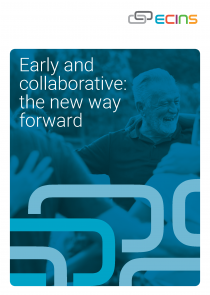Richard Norfolk, Reducing Offending Partnership Coordinator, Community Safety Team, Environment Commissioning Group, London Borough of Barnet, Email: Richard.Norfolk@barnet.gov.uk
Barnet use ECINS for Community Safety, Integrated Offender Management, Domestic Abuse, Domestic Violence, Community MARACS and ASB. Barnet’s Youth Offending Service also use the system to manage gangs and serious youth violence and Barnet Homes are looking to introduce the system to securely share information with their partners.
Richard Norfolk is the Reducing Offender Partnership Coordinator for Barnet’s Community Safety Team and has been using ECINS for IOM for the past two years. Richard said ‘There is widespread use of ECINS in Barnet to securely share information internally and externally with partners.
Most of our groups or cohorts are managed in a multi-agency way. Cohorts include the National Probation Service, Community Rehabilitation Company, Adult Social Services, Barnet Homes Housing, Drug and Alcohol Teams and DWP.
‘There are nine rehabilitation pathways that have a local SPOC and they all have access to ECINS so that when we are coordinating a multi-agency management plan of how we are going to manage an individual, all the information is shared securely and documented on ECINS which helps us to manage risk.’
Automatic Data Protection Safeguards
One of the benefits of ECINS is the data protection safeguards that are in place. Richard manages a number of teams and reports that practitioners find the system very easy to use and find it a simple process to get the information they require about cases.
Richard said ‘As soon as practitioners are given their login details they can get onto the system and start working straight away. If they do not have permission to view a particular profile it’s just a matter of sending a request for access. This ensures people are thinking about their reasons for viewing different sets of information and you only have access on a need to know basis. Practitioners start with limited access and they gradually build up the level of information they have access to.’
Combining Risk Matrices
The Mayor’s Office of Police and Crime are soon to be carrying out a review of Managing Persistent Violent Offenders in London. They are looking to introduce a new operational model for all of London that will improve their data capture and consistency of reporting. Part of Richard’s role is to encourage greater usage of ECINS and he has recently been working with Empowering-Communities’ Programme Manager Paul Dunn to develop a bespoke Persistent Vulnerability Pathway Matrix for IOM Users. Richard is in discussions with MOPAC with regards to them potentially adopting the Matrix as part of their IOM refresh for London.
Richard said ‘ECINS has already been adopted by MOPAC and is being accessed by 32 London Boroughs as part of the Rescue and Response Project which develops and delivers a support service for young people who are vulnerable and caught up in county lines drug distribution networks across the region.
‘I have been in dialogue with MOPAC to help them realise ECINS’ potential to revolutionise the Matrix by combining all the current Risk Matrices into one, effectively bringing information in from all sources. Rather than have a Risk Conference that is only police orientated this new combined Risk Matrix would include the Police IOM Risk Matrix, The Probation OGRS System and the Home Office Pathway Risk Matrix to come up with a combined risk score that takes into account all of the partner agencies’ scores. This would enable MOPAC to provide a more consistent approach.
‘Part of the IOM review process will include a requirement for all London Boroughs to report detailed offender information through to MOPAC. The reporting requirements include how many offenders within specific periods, whether there has been a reduction in offending, criminogenic need and rehabilitation pathways accessed. ECINS would offer many advantages in this area due its ability to bring in data from multiple agencies.
‘Our work in the IOM Team seeks to reduce reoffending by addressing people’s individual needs. If an offender has a drug habit, by working with them we aim to get their needs met to reduce their reoffending, reducing costs to society and the drain on the resources to the NHS, Housing etc. We are aiming to reduce the cost of crime in London. ECINS enables the multi-agency working practices to make this work a reality’.
‘The biggest benefit it brings to us is the ability to securely share information and the management of risk. If partners do not sign up and share information then they are leaving themselves vulnerable to organisational risk as the consequences of not sharing, acting or reacting to developing risk could be suicide or even homicide.
‘90% of our partnership are using ECINS to share information and those who don’t embrace it are leaving themselves vulnerable to risk and criticism for not sharing information in the most effective way.
‘It would be massively helpful if everyone in London was using ECINS to share information. The Youth Offending Team in Barnet report that the majority of children in the area who are involved in County Lines are those who have been excluded from school. Many of these children have come into crime via burglary and robbery.
‘There are many crossovers between the various teams – ASB, Youth Offending etc and someone involved in County Lines might also appear on our IOM radar for robbery.
‘By using ECINS we can map that activity and then track and monitor that individual. We have had cases in Barnet where individuals known to Barnet Youth Offending for burglary have been identified in another part of the UK and we’ve only been able to discover that through using ECINS.
‘It enables us to identify who the person is and link in with the intelligence to see if there is anything we could be doing to mitigate the risk of harm to this person and the wider community’.


